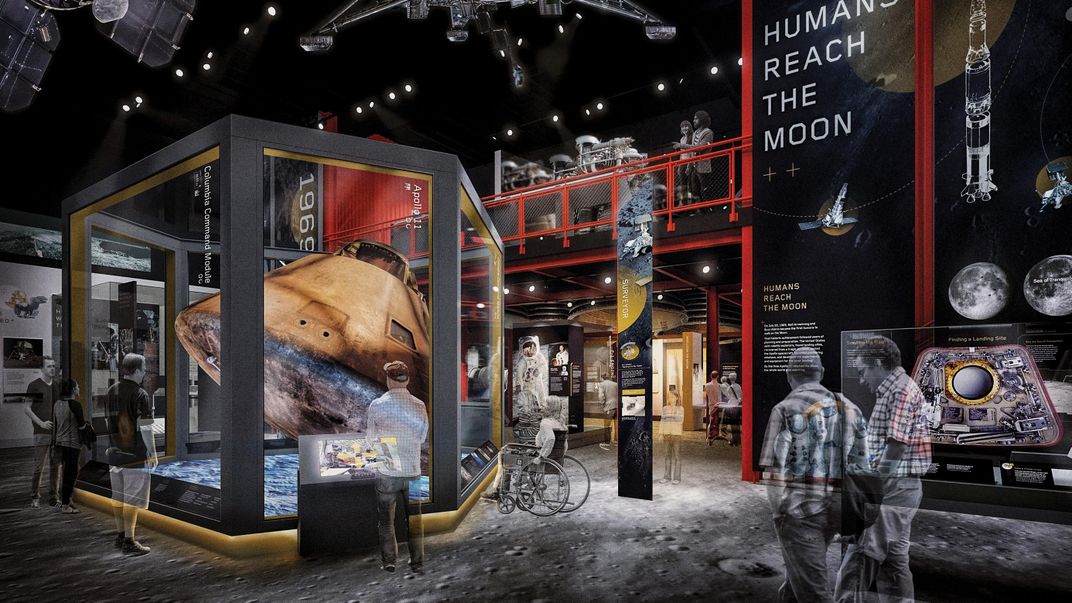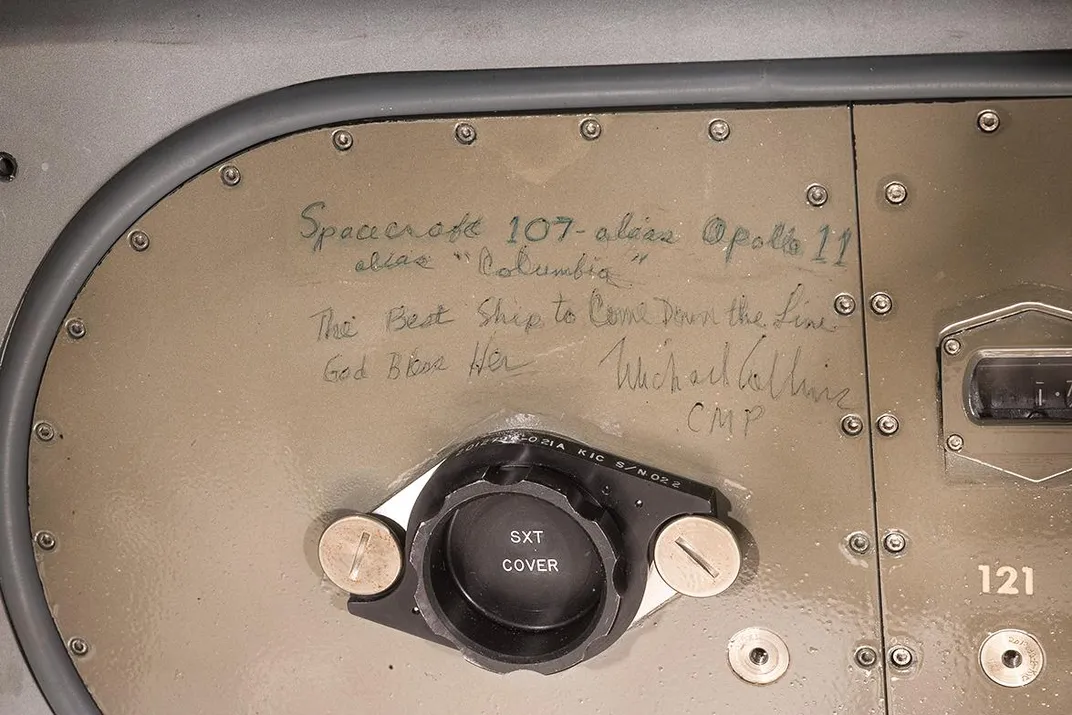The National Air and Space Museum’s New Take on Lunar Exploration
Destination Moon will tell the story with a post-Apollo audience in mind.
:focal(1624x626:1625x627)/https://tf-cmsv2-smithsonianmag-media.s3.amazonaws.com/filer/96/57/96578206-5e1b-45dc-a92b-29e83dcebcc0/bonestell_mural.jpg)
Millions of past visitors to the Smithsonian have fond memories of Apollo to the Moon, the National Air and Space Museum’s original exhibit about the 20th century space race. After opening in 1976, the gallery was modified several times over the decades, until construction to refresh the National Mall building began in 2018. Destination Moon, scheduled to open in 2022, is a worthy successor to that exhibit, a new telling of the lunar exploration story for the 21st century.
At the time Apollo to the Moon opened, almost all visitors had personally experienced the moon race, if only through their TV sets. The exhibit had many historic artifacts on display, including a giant F-1 engine from the Saturn V rocket and Armstrong’s and Aldrin’s Apollo 11 spacesuits. But there was little in the way of explanation or context.
When the curatorial team began planning the replacement exhibit a decade ago, we could no longer assume the average visitor knew much about the cold war or the 1960s space race. Already by then, the majority of our visitors had been born after Apollo. And we could no longer end the story with the last astronaut landing—robotic lunar exploration had resumed in the 1990s. Destination Moon will therefore present lunar exploration in a broader frame, from ancient dreams to missions still in the planning stage.

When visitors enter, they will see above them artist Chesley Bonestell’s giant, 10-foot by 40-foot mural, A Lunar Landscape. He painted it for the Boston Museum of Science’s planetarium in early 1957, six months before Sputnik, and it shows the moon as we then imagined it would be, with razor-sharp mountains. Underneath the mural—which is currently undergoing a careful restoration—objects, photographs, and explanatory text will cover two millennia of imaginary lunar flights, leading up to efforts in the 1950s to sell space travel, often using Bonestell’s artwork.
Next, visitors will learn about the early space race with the Soviet Union. In 1961, after Yuri Gagarin became the first human spacefarer, President John F. Kennedy challenged the nation to “land a man on the moon and return him safely to Earth” before the end of the decade. A short video about this monumental decision and speech explains why the president and Congress were willing to spend billions of dollars to beat the Soviets.
Immediately adjacent to the Kennedy display is Alan Shepard’s Freedom 7 Mercury capsule, one of the original Apollo to the Moon objects. On May 5, 1961, Shepard became the first American in space—a necessary success before Kennedy would commit to the lunar landing.
The center of Destination Moon tells, over two floors, the exciting story of how the nation rose to that challenge. On prominent display are the giant Saturn V first-stage engines from the old gallery. Some may recall how one F-1 engine nozzle and a section of another were displayed with mirrors on two sides to create the illusion of seeing all five engines on the Saturn V’s first stage. Now we lift the artifacts up to the ceiling, again with mirroring. One can walk beneath them on the first floor, or see them up close on the mezzanine.
Also on the first floor are four large pieces of the F-1s used on Apollo 11, which were recovered from the ocean floor in 2013 by an expedition funded by Jeff Bezos. Not far away are the Gemini VII spacecraft that figured in the first space rendezvous and Neil Armstrong’s A-7L lunar spacesuit in its state-of-the art exhibit case.
The upper deck details the challenge of designing that suit, and illustrates life aboard the Apollo spacecraft, along with the critical contributions of pre-launch simulations and Mission Control. The mezzanine will be a spectacular overlook for viewing the gallery’s three giant murals: Bonestell’s painting on the entry wall, the Apollo 8 Earthrise image on the back wall, and a panorama from Apollo 17 on the exit wall. In the gallery’s center, appropriately, sits the Apollo 11 command module Columbia, back from a national tour in 2019. Above it hang Ranger and Surveyor, two of the U.S. robotic spacecraft that paved Apollo’s way.
The lunar module cockpit from Apollo to the Moon also returns—now playing video of the last two minutes of the Apollo 11 landing, but with an updated simulation of Armstrong’s view out the left window, matched with actual footage taken through Aldrin’s right window.
Around the corner, the exhibit shows how subsequent Apollo expeditions explored the moon scientifically. A lunar rover like the one used on the last three landings sits on a simulated lunar surface, along with key experiments like the telescope designed by African-American astronomer George Carruthers, which became the first observatory on the moon during Apollo 16. (The gallery exhibits the backup telescope.) Throughout the gallery, we highlight the crucial contributions of minorities and women to the space program.
/https://tf-cmsv2-smithsonianmag-media.s3.amazonaws.com/filer/ee/4d/ee4d432f-44fd-4704-ab29-af0ca9b6f959/12s_fm2021_replacessjsc2004e52773_live.jpg)
Destination Moon closes with the return of lunar exploration. Above hangs a structural test version of NASA’s Lunar Reconnaissance Orbiter, which has been mapping the surface since 2009. Next to that is a model of the huge SLS booster that NASA hopes will launch astronauts there in the near future.
As lunar exploration heats up again, we expect the new exhibit will be a magnet for visitors in the completely transformed Museum. It will introduce new generations to how, when, and why humans dreamed—then did more than dream—of exploring that beautiful disk in the night sky.
Space historian Michael J. Neufeld is the lead curator of the Destination Moon gallery. He is responsible for the National Air and Space Museum’s Mercury and Gemini spacecraft and its collection of rockets and missiles. Neufeld is the author of several books, including a biography of Wernher von Braun and Spaceflight: A Concise History.
Destination Moon is made possible by the generous support of:
Apollo 11 Commemorative Coin Program | Jeff and Mackenzie Bezos | Joe Clark | Charles and Lisa Simonyi Fund for Arts and Sciences | Bruce R. McCaw Family Foundation | Elizabeth H. and James S. McDonnell III Fund (at the St. Louis Community Foundation) and The JSM Charitable Trust | John and Susann Norton | Phillip N. and Mary A. Lyons | Gregory D. and Jennifer Walston Johnson | Barry D. Friedman | Leora and Derek Kaufman | FedEx Corporation | The Beall Family | Milann H. Siegfried | OMEGA | Robert Procop
/https://tf-cmsv2-smithsonianmag-media.s3.amazonaws.com/filer/5a/5b/5a5b538b-35dc-4e80-b953-202360b5d13c/12h_fm2021_lunarrovervehicle-nasm2020-00046_live.jpg)

